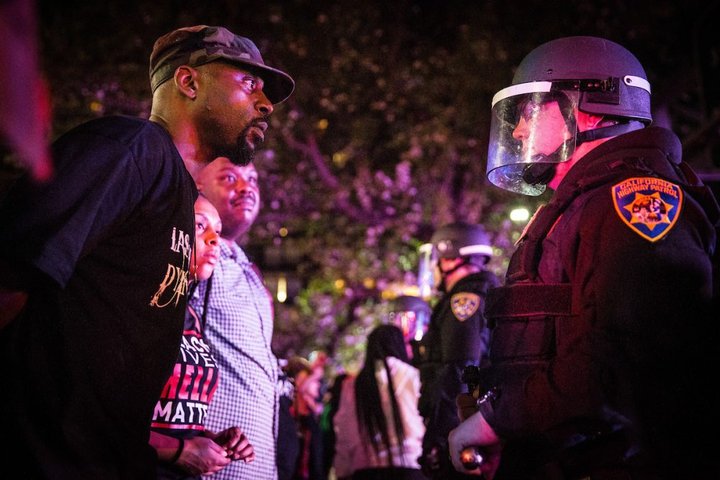
SACRAMENTO, CALIFORNIA - MARCH 30, 2018: A Black Lives Matter protestor stares at a California Highway Patrol Officer blocking their access to Interstate 5. In the days since Stephon Clark, 22, was fatally shot by officers investigating a vandalism complaint in his south Sacramento neighborhood, protesters have stormed City Hall and taken to the streets in anger. Photo by Max Whittaker.
###
After months of negotiations to craft a bill meant to reduce police shootings in California, legislative leaders have landed on a version that appears likely to pass, with law enforcement groups removing their opposition, civil liberties advocates declaring victory and Gov. Gavin Newsom lauding a policy that “will help restore community trust in our criminal justice system.”
Assembly Bill 392 — inspired by the death last year of Stephon Clark, an unarmed man Sacramento police killed after mistaking the cell phone he was holding for a gun — would give California a new and tougher legal standard to justify the use of deadly force by police.
It says police may only use deadly force when “necessary in defense of human life” — a steeper standard than prosecutors apply now, which says police can shoot when doing so is “reasonable.” Supporters say the policy will save lives by putting new limits on police.
“Assuming this bill passes, then California will have one of the strongest use of force laws in the nation,” said Lizzie Buchen, a lobbyist for the American Civil Liberties Union, a key backer of the bill.
“It retains the core elements that we’ve always had, which is that officers can only use deadly force when it is necessary and that ‘necessary’ includes the actions of the officers leading up to the force.”
But the new version of the bill doesn’t go as far as originally proposed, removing some key provisions that were particularly loathed by law enforcement. It removes a section that would have held officers criminally liable in cases of criminal negligence resulting in someone’s death. It also deletes a definition that says a “necessary” use of force is when there is “no reasonable alternative.” Police objected to that wording, arguing it would encourage prosecutors to second-guess their actions in hindsight.
“It’s clearly a compromise,” said Seth Stoughton, a professor at the South Carolina School of Law, who has studied use of force standards around the country and supported the initial version of the bill.
“As a matter of policy, there are some things that I liked that were taken out of the bill. But as a matter of politics… it’s probably correct that you start with a strong bill and then the legislative process involves a series of compromises.” Stoughton added that even with the compromise language, the strictness of California’s standards would be in the nation’s “top tier.”
The bill’s author, Assemblywoman Shirley Weber, had promised to work with police to find some common ground after the bill passed a committee with tepid support from some of her fellow Democrats. The original version of her bill appeared unlikely to pass the full Assembly as long as police groups remain opposed.
With their agreement to go neutral on the new version, passage appears nearly certain when the bill faces a vote on the Assembly floor next week. It must then go through the Senate before reaching Newsom’s desk.
Law enforcement groups have proposed their own bill intended to reduce police shootings with more training and tougher police department policies. Senate Bill 230 has become a companion measure to Weber’s bill and would train officers on the new standard and alternatives to drawing their guns. It faces a vote of the full Senate, likely next week.
###
CALmatters.org is a nonprofit, nonpartisan media venture explaining California policies and politics. Follow this issue as it moves through the Legislature this year with CALmatters’ podcast, Force of Law.
CLICK TO MANAGE